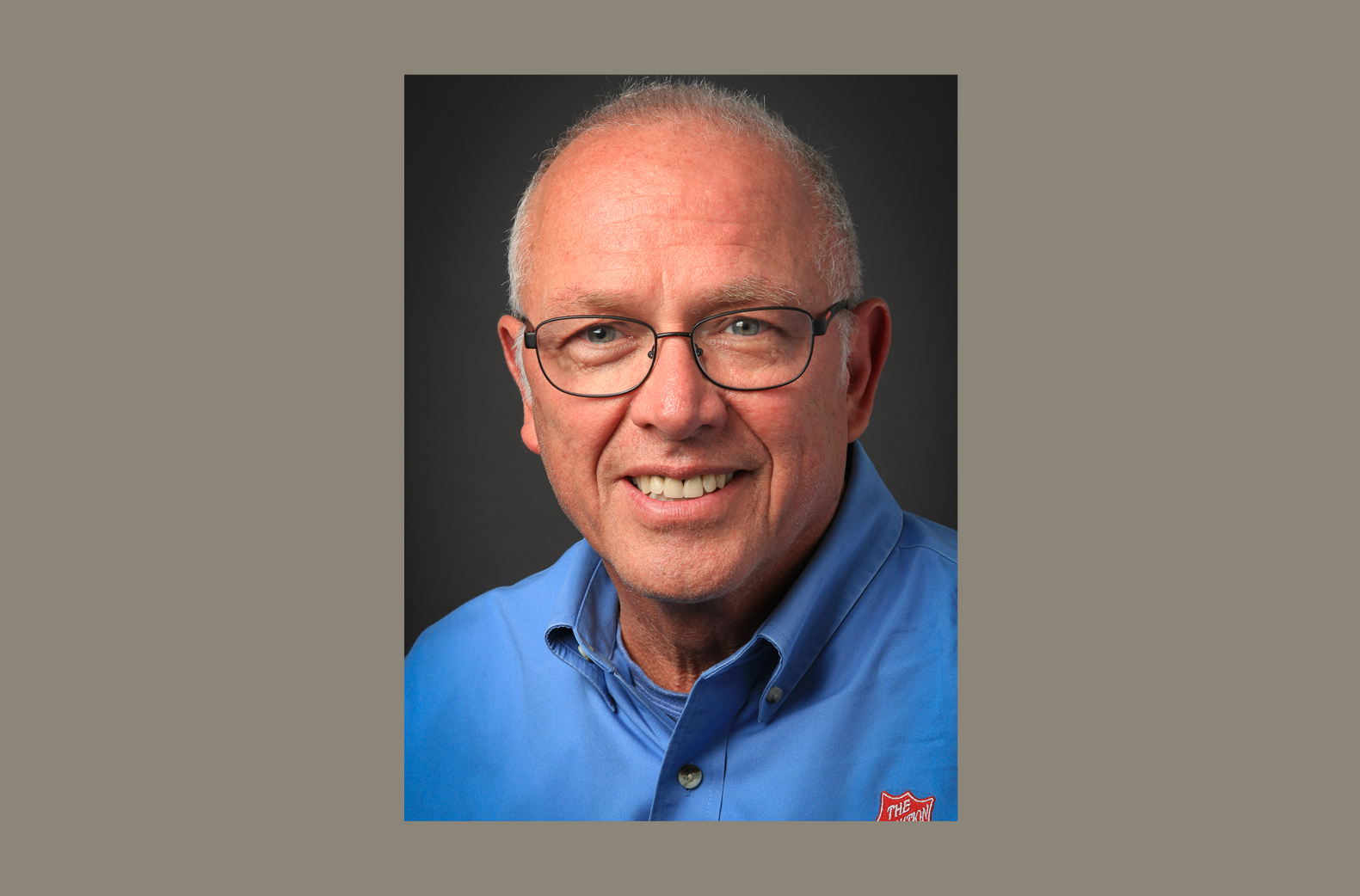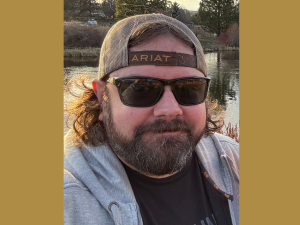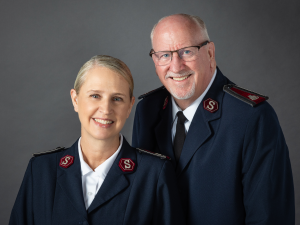The Salvation Army has a long history of responding when disaster strikes.
Drought, wildfires, flash flooding, tornadoes, earthquakes, and the manmade kind too. Every disaster is unique and creates its own special needs.
That’s why the heart of The Salvation Army’s disaster response is to meet the immediate needs of a survivor and the emergency responders there to help with food, clothing, shelter, communications, donations management, cleanup, training and more.
And every step of the way The Salvation Army offers emotional and spiritual care. It’s that ministry of presence The Salvation Army considers one of its highest honors.
For more than 20 years, John Berglund has been on the frontlines of Salvation Army disaster response. He’s served as the Emergency Services Director at The Salvation Army’s U.S. National Headquarters, in the Greater New York Division, and in the Intermountain Division based in Denver before his current role as the Emergency Disaster Services Coordinator of The Salvation Army Western Territory. He also serves as a team leader and trainer for International Emergency Services through The Salvation Army’s International Headquarters in London.
And at recording time, he’s about to deploy to Eastern Europe to assist in the on-the-ground assessment of needs and how The Salvation Army can best help right now during the humanitarian crisis unfolding in and around Ukraine.
He’s on the show today to share more about what’s happening in the current disaster response, what he’ll be doing from Moldova and to give us a better context for how The Salvation Army counters disaster.
Show highlights include:
- John Berglund’s story and what led him to his role today.
- Why he is passionate about disaster response, especially through The Salvation Army.
- An experience that stands out to John after numerous deployments to serve in overseas disasters.
- What the role and response of The Salvation Army is when disaster strikes.
- The variables that affect the successful delivery of humanitarian aid in a disaster.
- What The Salvation Army is doing in and around Ukraine now in response to the current humanitarian disaster.
- What John will be doing during his four-week deployment to serve International Emergency Services from Moldova.
- What he is hoping to contribute on this disaster deployment.
- The one thing John wished people understood about responding to disasters.
- How we prepare for a disaster in the Western Territory.
- The best way for someone to get involved or support The Salvation Army’s disaster work.
Listen and subscribe to the Do Gooders Podcast now. Below is a transcript of the episode, edited for readability. For more information on the people and ideas in the episode, see the links at the bottom of this post.
* * *
Christin Thieme: John, welcome to the Do Gooders Podcast. Thank you for being here with us today.
John Berglund: You’re very welcome. And thanks for the invitation.
Christin Thieme: Can you share, as we start out here, a bit about your story? Kind of the highlights of what led you to be who you are here today?
John Berglund: The Cliff Note version, correct?
Christin Thieme: Yes.
John Berglund: My Cliff Note version has taken me through a number of places with The Salvation Army. So I was introduced to The Salvation Army through Camp Ladore in the Eastern Territory. I served as a camp counselor, the village leader, during my college years for about three summers in a row.
From there, a fellow by the name of Todd Bassett enticed me to serve at the Pioneer Corps in Northwest Philly as a youth director. So following that for a couple years, I then went a different path for one reason or another and I ended up in the nonprofit world, manning professional arts agencies professionally. And I did that for about two decades.
I resurfaced with the Southwest Division around 2000. Eda Hokum hired me to work service extension and EDS. And then from there, I went to Western THQ as EDS trainer. And during that time that I was in the Southwest Division, I was also teaching nonprofit management at Arizona State University for 10 years. Following the Western THQ as a trainer, George Hood brought me to NHQ as the national EDS director. And I served there for a number of years.
And then following Katrina, I moved to greater New York to head up the EDS program for a number of reasons. My parents are from New York. We’re immigrants in New York. I was raised in upstate New York. And then following that, I went to Intermountain, which is where my family is located now in Denver. And then shortly after that, I returned to the Western Territory in this position overseeing emergency services.
Meanwhile, through all of that, since 2003, I’ve served as a team leader and trainer for International Emergency Services with IHQ. So that’s the Cliff Note version of my Salvation Army path.
Christin Thieme: Yeah. And you’ve gotten to see The Salvation Army in a whole slew of places. I love it.
John Berglund: I have. And I’ve appreciated every moment of it.
Christin Thieme: So in your role now, as the Western Territory Director of Emergency Disaster Services, can you give us a little snapshot? What does that mean? What do you do?
John Berglund: As the territorial coordinator or director for emergency services, my job is actually to support the divisional directors. It sounds massive because of the geographical area of the territory, but my job is to work with the divisional directors, provide them with training, with resources, and bring support to the different divisions. In times of crisis, I’ll be working with national resources, with regional resources, and also moving assets, personnel, and equipment and such so the sister divisions can help each other when needed.
Christin Thieme: Many of your roles have been related to disaster response with The Salvation Army. Why were you drawn to this work? Why are you passionate about disaster response?
John Berglund: Helping others. I think I’ve always been in the nonprofit field my entire career. I didn’t really choose The Salvation Army, The Salvation Army chose me. It seems that over the years, my path always came back to The Salvation Army for one reason or another.
Working in the professional arts world for several decades, the arts are amazingly diverse. They don’t tolerate discrimination. They pursue social justice. They help to educate. I found all of those elements the same in The Salvation Army, although through the provision of providing humanitarian aid. So it’s always been part of me, it’s always been part of my faith, and it’s always been an expression of my faith, whether through one organization or another, but with The Salvation Army, it’s been a perfect fit.
Christin Thieme: I love it. In these roles, I know you’ve deployed to serve in numerous disasters, both here in the U.S. and overseas. What’s one experience that really stands out to you through the years?
John Berglund: Oh, there’s many. Every major incident has its own personalities. It has its own challenges. There’s lessons learned every time you go out. And as I say often in training, one has to walk the boards to learn the craft. Never say no to a deployment. The more you get out there, the more you do the work, the more you learn and you understand.
My first large international deployment was through IHQ into Iraq after the fall of the Ba’athist government. That was probably the most rewarding and made the greatest impact on me, both because the work was sizeable, I think we restored 36 schools in three months and clinics and literization programs and a variety of things, but that, and not only was it that incident, but also the folks that trained me at that time were incredibly professional with incredible skills.
So in those early years, I learned a lot from going out and being with those who had the most experience. Just quickly though, when I look at all of the events, they were all milestones in different ways. Although it was domestic, 9/11 was probably the saddest incident that I’ve ever been on and that was because it was on the home court. Katrina was another milestone, a lesson in non-profit politics and resulted in major changes in the NGO sector. The Haiti earthquake in 2010 was an interesting exercise in coordination, both internally for The Salvation Army and externally with NGOs and government agencies. Also, the Haiti earthquake made a lasting imprint because the death count was so high. Two to 300,000 people trapped in rubble. Yolanda in the Philippines was one of the best bonding experience I had with locals because I worked mostly with Filipino officers. So that was very, very positive. And then, not too long ago, I conducted a project, evaluations for IHQ in Vanuatu, which was probably the most remote and the most exotic of any place I’ve ever been.
Christin Thieme: You have a wealth of experience. I know we could talk for hours about everything that you’ve learned through all of these deployments, but can we back up a little bit? For somebody who’s not that familiar with what happens in an emergency response—when a disaster strikes, what is the role of The Salvation Army? Can you walk us a little bit through what happens?
John Berglund: Yeah. There’s a national expectation that The Salvation Army is going to respond. It’s who we are. It’s what we do. Now, it’s going to differ by the hazard. There’s a sizable number of variables. It’s going to differ by the geography. It’s going to differ by the hazard. It’s going to differ by The Salvation Army presence, what the capacities are of The Salvation Army.
In the States for the most part, and in the Western Territory specifically, I would say most of our divisions are tied very heavily with state and local government. So we’re written into a number of emergency management plans.
There’s different models on how The Salvation Army responds in one territory. It may be a model where we just flood the community with a number of roaming canteens, which is a good model and works for some, but it doesn’t work in all places.
I think one, to answer your question, it differs. It differs by location and by incident. But also I think the skill of The Salvation Army is our ability to get in quickly to assess the situation. And we have tremendous freedom to fill in the service gaps. To say, “Look, maybe there’s 18 agencies feeding, but there’s something else that we could do in donations management or there’s a gap that we could fill in the shelters providing emotional and spiritual care.” So it differs.
Although, a lot of it is in the planning. Often people say, “Well, when there’s no disaster, what are you doing?” And what we’re doing is we’re planning. We’re planning and we’re forming relationships and we’re forming partnerships and we’re doing what I would call sound stewardship in getting ready for what could happen.
Christin Thieme: Maybe you could talk a little bit more about that. How do we go about preparing for a disaster? What do you do when you’re not in a disaster?
John Berglund: Again, sound stewardship. I think there’s a responsibility to think forward, to prepare not only for ourselves, but for our families, but also in our jobs for the personnel, the programs, and the property that we are asked to oversee. I think not to have an eye on what could happen in emergencies and not to prepare is a misstep. I think part of it is education, education, education on the part of THQ and the DHQs to just constantly remind our units and our programs that that element is one we always have to keep an eye on.
Christin Thieme: What actually goes into the successful delivery of this kind of humanitarian aid you’ve talked about, whatever it might be? Whatever gap we’re filling, what affects the successful delivery of that in a disaster?
John Berglund: The successful delivery of humanitarian aid, I think the key to that is finding the appropriate niche for The Salvation Army to provide services. Ever since Katrina, the field, the nonprofit sector within disaster response exploded. We’re now in a billion-dollar industry which is highly competitive. So it’s important for the Army to figure out the right niches. And again, there’s a lot of variables on the incident and the location, but to figure out the right service niche that matches the resources that are donated to us, we’re delivering those in the proper way, we’re making an impact in survivors. Some of that can be in response for the provision of emergency aid right away. And now, we do more work in recovery than we ever have before. Depending on the size of the donations, the amount of the donations that come in, we could be working on a project for two or three years helping survivors to develop long-term recovery plans and to see those plans fulfilled.
Christin Thieme: I know some of that has happened with the fire responses that we’ve seen in California.
John Berglund: Yup. Absolutely. And people don’t realize that those projects go on for years. They don’t stop after the response phase or after the cameras go away.
Christin Thieme: Yeah. So you’ve already shown us that disasters come in all shapes and sizes. Right now, we’re all watching, basically, as a humanitarian crisis unfolds across Eastern Europe. Can you share more about what The Salvation Army is doing in and around Ukraine in response?
John Berglund: Okay. Well, as you know, the Army has a long history of serving in war zones, so times haven’t changed much, have they? Hundreds of thousands of refugees are pouring into Poland and Hungary as well as into Romania and Moldova. So far, to date, from what we know, The Salvation Army is assisting refugees at reception centers, they’re providing feeding, they’re distributing emergency supplies. They’re escorting refugees from location to location, if not to a border. And in some cases, we’re actually sheltering in Salvation Army facilities. So as I said before, as all the global NGO players respond in these different countries, and there are more and more responding every day, The Salvation Army will continue to assess the best service gaps for us to tackle in that situation.
There shouldn’t be a duplication of services. It takes an assessment period to figure out what feels right with our mission and that response could be all of the above that they’re doing right now. But this is going to go on for months and months, if not years. And for the most part, we live in these countries. We live in these communities. So there’s no exit plan. We’re not coming in as the outside NGO. We live there. We’ll provide services as long as they’re needed and as long as the funding is there to do the work.
Christin Thieme: And you’re going over. You’re being deployed in just a few days here to serve for four weeks with The Salvation Army’s international emergencies services in Moldova. Can you talk a little bit more about where you’ll be and what you’ll be doing?
John Berglund: Yes. I’ll most likely be flying into Romania first and then traveling by road into Moldova because the airspace is closed. What I’ll be doing at THQ is working with the local teams to assess the situation. And I’ll also be training the local teams. So at this point, IHQ I know has assigned three small teams to go and team leads to go into Poland, to go into Romania, and to go into Moldova. So we’ll go in and assess.
As I said before, we’ll go in to try to figure out the right service niches for The Salvation Army. We’ll take an evaluation of the different resources that are coming our way.
And then in international work, it’s a lot of grant writing. It’s a lot of projects. So we’ll be assessing the best projects, then we’ll be putting together project proposals. Those project proposals will be going out to Salvation Army territories all over the world that are accustomed to funding these type of projects. And then also, I imagine, out into the corporate world for support as well. So it’s a lot of assessments in the beginning and it takes weeks to settle down and figure out this is the right niche for us and this is what we’re going to do. I’m part of the assessment teams on the frontline.
Christin Thieme: So when you’re going into a response like this, what are you personally hoping to contribute to this particular response?
John Berglund: Twenty years of experience. Like I said, that’s helpful so we don’t make the same mistakes and what’s worked in the past, what hasn’t worked in the past. I enjoy training and empowering the locals.
That’s always gratifying for me. And then ensuring that the aid actually reaches the field and actually makes a difference is really important.
Christin Thieme: Yeah, absolutely. Well, we’ll be thinking about you while you head out.
John Berglund: Thanks. I appreciate it.
Christin Thieme: What would you say is one thing that you wish people better understood about what all it takes to respond to a disaster?
John Berglund: By the grace of God, we get it done. For me, it’s really an exercise in faith. I’ve worked in the NGO field my entire life, both in the faith side and in the secular side. And the beauty of working in the faith sector is, if you stay centered and you have to take care of yourself, both physically, mentally, and spiritually, but if you can stay centered, you’re really just there for the ride. And somehow, by the grace of God, it works out.
Christin Thieme: Yeah. What about here in the Western U.S.? Are we still responding to any ongoing disasters?
John Berglund: Well, right now, it’s what we call blue skies. So it’s the time of preparedness and reminding everyone, especially in the Western Territory, to prepare for wildfire season, as wildfires now affect every division in the territory, every single one. And also training. So there’s a number of divisions that will be doing in-person training and we’re starting to push out online training as well to get the information to as many people, employees, staff, and volunteers as possible.
Christin Thieme: Blue skies. I like it. Knock on wood.
John Berglund: Blue skies.
Christin Thieme: So what is the best way for someone, maybe somebody who’s listening, to become more involved or to support The Salvation Army’s disaster work?
John Berglund: Start by volunteering at a local corps. By volunteering at a local corps, you’re going to start to understand… If you’re not familiar with The Salvation Army culture, if you’re not familiar with The Salvation Army as a church, as a faith-based agency, start volunteering at a local corps. And then look at whether that local corps has an emergency team that will help you get plugged in. Or if you want to help the corps officers develop such a team to respond to crisis in that community.
You can also contact the divisional EDS director, emergency services director. Every division has one point person whose responsibility is to work with emergency services during times of crisis. And lastly, you just need to get out there and walk the boards. You just need to find a way to get out there and do the work. And when you do the work again and again, you learn more and more, and you figure out, is this the kind of work that I want to do? And you also figure out what type of work do you want to do? Do you want to work in the office providing essential finance and admin responsibilities? Do you want to be on the front lines, preparing food? Are you called to provide emotional and spiritual care and work directly with survivors?
Christin Thieme: Well, head to caringmagazine.org/give, and you can see more about how to go about volunteering, giving your time and more.
John, thank you so very much for sharing with us today, especially as I know you have a long checklist before you get on a plane in a couple days, so thank you for sharing, and hopefully, we can connect again while you’re there and see how it’s going there on the ground.
John Berglund: Okay. Thank you very much, Christin.
Additional resources:
- See how The Salvation Army responds in disaster.
- Find current updates on The Salvation Army’s response to the Russia-Ukraine conflict.
- It’s because of people like you that The Salvation Army can serve more than 31 million Americans in need each year. (That’s almost one person every second, every day.) Your gift helps The Salvation Army fight for good all year in your community. It’s an effort to build well-being for all of us, so together we rise. And that good starts with you. Give to spread hope with a donation of funds, goods or time today.
Listen and subscribe to the Do Gooders Podcast now.













